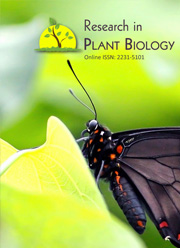Population dynamics of Fusarium oxysporum f.sp. niveum and F. solani f.sp. cucurbitae in commercial watermelon fields in Tunisia
Abstract
Experiments were conducted in field plots to evaluate the level and the dynamic population of Fusarium species propagules of in three commercial watermelon fields inTunisia surveyed two successives years. Populations of Fusarium oxysporum f. sp. niveum and F. solani f. sp. cucurbitae in naturally infested fields of watermelon were enumerated by soil dilution method and subsequent pathogenicity tests. The results showed that Fsc colonies number recovered from the field soils was higher than the value of Fon colonies,in each field and for the two years. Before planting, the density of Fsc propagules in thefield soils was higher than the number of Fon colonies, in each field and for the two years.It varies from 193 to 128 propagules/g soil for the 1st year and between 986 to 568propagules/g soil in the 2nd year for field II. The highest inoculum density of Fsc was found at Field II (986.67±172.09 CFU g-1 soil) during the 2nd year, before plantation. Pathogenicity test revealed that for pathogens isolated from the deep 20-30 cm, the number of pathogenic colonies is relatively lower and counted between 40 to 70%.Downloads
Download data is not yet available.
Published
15-08-2011
How to Cite
H., B.-M., H., C.-R., & Armengol, J. (2011). Population dynamics of Fusarium oxysporum f.sp. niveum and F. solani f.sp. cucurbitae in commercial watermelon fields in Tunisia. Research in Plant Biology, 1(3). Retrieved from https://www.updatepublishing.com/journal/index.php/ripb/article/view/2581
Issue
Section
Articles



 .
. 